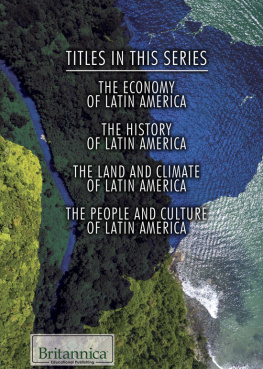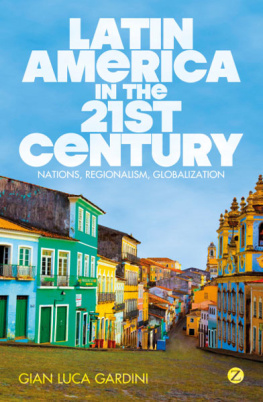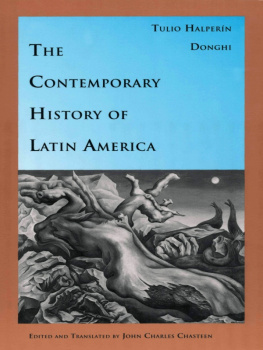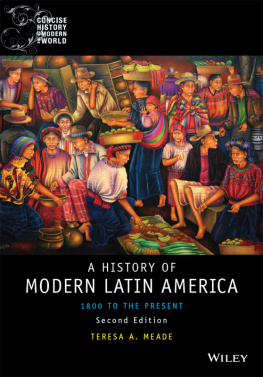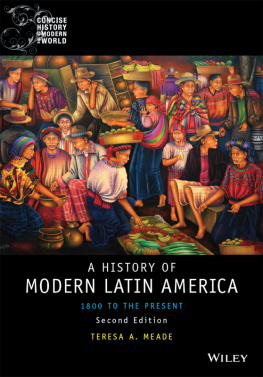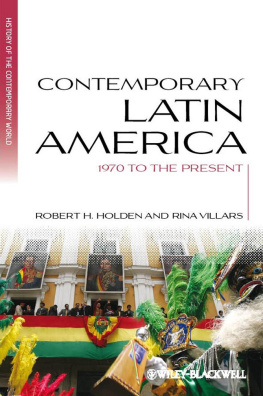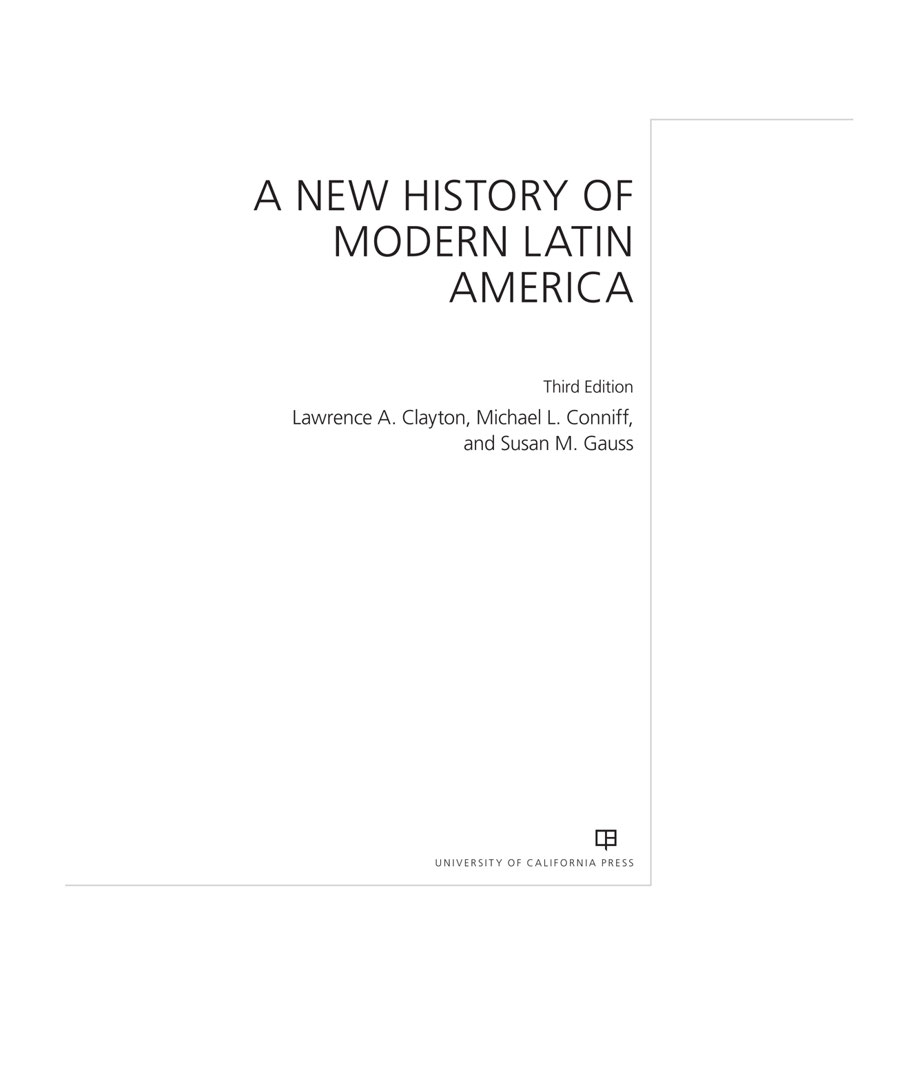A New History of Modern Latin America
A NEW HISTORY OF MODERN LATIN AMERICA
Third Edition
Lawrence A. Clayton, Michael L. Conniff, and Susan M. Gauss
UNIVERSITY OF CALIFORNIA PRESS
University of California Press, one of the most distinguished university presses in the United States, enriches lives around the world by advancing scholarship in the humanities, social sciences, and natural sciences. Its activities are supported by the UC Press Foundation and by philanthropic contributions from individuals and institutions. For more information, visit www.ucpress.edu.
University of California Press
Oakland, California
2017 by The Regents of the University of California
Library of Congress Cataloging-in-Publication Data
Names: Clayton, Lawrence A., author. | Conniff, Michael L., author. | Gauss, Susan M., author.
Title: A new history of modern Latin America / Lawrence A. Clayton, Michael L. Conniff, and Susan M. Gauss.
Other titles: History of modern Latin America
Description: 3e. | Oakland, California : University of California Press, [2017] | Includes bibliographical references and index.
Identifiers: LCCN 2016053808 (print) | LCCN 2016056615 (ebook) | ISBN 9780520289024 (pbk. : alk. paper) | ISBN 9780520963825 (eBook)
Subjects: LCSH: Latin AmericaHistory19th century. | Latin AmericaHistory20th century.
Classification: LCC F1413 .C63 2017 (print) | LCC F1413 (ebook) | DDC 980/.02dc23
LC record available at https://lccn.loc.gov/2016053808
ClassifNumberPubDate
DeweyNumberdc23CatalogNumber
Manufactured in the United States of America
24 23 22 21 20 19 18 17
10 9 8 7 6 5 4 3 2 1
Contents
1 Background to Independence
2 The Coming of Independence to South America
3 The Independence Movements: On to Victory
4 The Aftermath of Independence
5 The Search for Political Order: 1830s1850s
6 Order and Progress
7 Citizen and Nation on the Road to Progress
8 The Development of Nations: Mexico and Central America
9 The Development of Nations: South America
10 Inventing Latin America
11 Changing Worlds and New Empires
12 Early Populism in South America
13 Dictators of the Caribbean Basin
14 Divergent Paths to Modern Nationhood: Panama, Brazil, and Peru
15 Early Revolutionaries: Mexico, Brazil, and Nicaragua
16 The 1930s: Years of Depression and Upheaval
17 Latin America in World War II
18 The Classic Populists
19 Mexico since World War II
20 Colombian Conundrum
21 Caribbean Basin Countercurrents
22 The Cuban Revolution and Its Aftermath
23 The National Security States
24 Democratization and Conflict in the Late Twentieth Century
25 Latin America in the Twenty-First Century
Preface
This third edition, now entitled A New History of Modern Latin America, retains the key features that have distinguished it from other general histories of Latin America covering the nineteenth through the twenty-first centuries. With an emphasis on historical narrative and biography, it draws out the richness of the regions past in ways that appeal to the college undergraduate who is learning about Latin America for the first time. This textbook also brings to light recent interpretations and analyses of the past in an entertaining and readable style. It is designed with a survey class in mind, and for instructors with in-depth knowledge of the field. Its narrative approach also makes it useful for those instructors who have less familiarity with the region, who can use the textbook as a guide for organizing the course by assigning one or two chapters per week.
The third edition presents an interpretation of the major events in Latin American history from the Wars of Independence in the early nineteenth century to the democratic turn at the start of the twenty-first within a chronologically organized narrative. The men and women of Latin America are the heart and soul of this history, and the writing style allows their voices to be heard across the years. Each chapter opens with a document from that chapters period or theme. Thus, a letter penned by the Liberator, Simn Bolvar, introduces chapter 2. Information gleaned from documentsdiaries, journals, letters, newspaper articles, legal petitions, notary public records, and the likehelp stitch together the record of the past. The use of many document samples gives readers a feel for people who lived in earlier times. Each document is preceded by a short introduction to place it in the context of the chapter.
We have tried to be comprehensive by giving attention to each of the nations of Latin America. While the biggest and most populous nationsMexico, Argentina, and Braziltake up a significant amount of our attention, we have highlighted important events in the histories of all nations, from Chile in the south to Cuba in the northern Caribbean. Major themes are woven into these pages, from the age of caudillos in the nineteenth century, to populism in the twentieth century, to globalization and its impact in the twenty-first century. These themes tie together the multitude of individual national histories, adding broader understanding of the whole hemisphere. Certain themesethnic strife, populism, social and economic revolutions, and militarism, for exampletranscend borders, giving Latin America its unity of experience, even while an extraordinary diversity marks the regions geography, peoples, and cultures.
This edition maintains the key pedagogical features of its predecessors. Textboxes with topical readings and primary documents appear throughout the text. These bring the contents to life with vivid descriptions by the historical players and witnesses themselves. They also highlight basic concepts (e.g., dependency theory, race relations, and political alignments) intrinsically important for a deeper and clearer understanding of Latin American history. This edition also has about one hundred images and maps to enhance and enrich the readers learning experience. Each of the five parts in this textbook has an updated introduction to give the reader a sense of the flow of events and their significance in the chapters that follow. We have included three new pedagogical features in each chapter: discussion questions, a timeline of events, and an updated keywords list. The bibliographies from each section, as well as the general bibliography, have been updated and are now located at the back of the text. These bibliographies are not comprehensive, but rather are designed to give students a place to begin research on individual topics suggested by the more general treatment afforded in the text.
The third edition includes significant revisions that enhance, update, and expand on the prior edition, in addition to changes to style and organization aimed at improving clarity. It has up-to-date interpretations drawn from advances in fields such as Atlantic World, race, and gender history; adds substantial new material on women and gender; and includes new textboxes to bring in more diverse historical biographies. A chapter on culture in the second edition (chapter 17) has now been broken apart and included in the narrative of other thematic chapters in order to emphasize the critical role of culture and society in large-scale political and socioeconomic changes. The third edition also includes a final chapter (chapter 25) that brings the text into the second decade of the twenty-first century. The revisions to the third edition can be summarized as follows:


